人教版高中英语必修三Unit2Healthyeatingword全单元教案
高一英语人教版课标必修3unit2healthyeating教案2

Food that provides energy (eg. Energy-giving food)
Food that helps grow bones and muscles (eg, body-building food)
2、语言目标(Language aim)
Learn some words andexpressionsabout healthy diet.
a healthy diet, energy-giving food, body-building food,protective-food,a balanced diet
1.Ask the students to listtheirfavorite foods on paperandcomparethemin groups.
2.Discuss whether the foodsdogood to health or not.
Step IV.Activity 3Classification
三.教学难点(Teaching difficult points)
To get the students to talk using their familiar words and expressions
四.教学方法(Teaching method)
Introduction, discussion, and competition.
StepVI. Activity 5 Competition
Let the students to take part in a competition of making up balanced meals to see which group can make the best meals for our daily life.The teacher also gives his/her choice of foods for a balanced meal.
人教版必修三Unit 2《Healthy eating》word教学设计
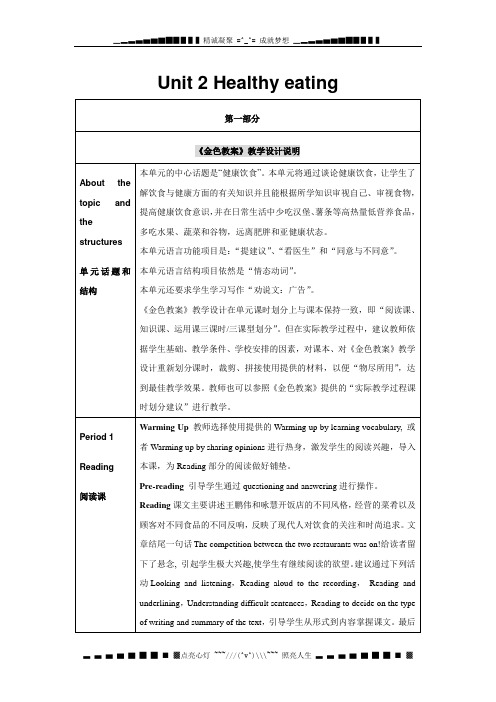
Pre-reading引导学生通过questioning and answering进行操作。
将Warming Up、Pre-reading、Reading和Comprehending整合在一起上一节“阅读课”。
将Learning ab out language和Workbook中的USING WORDS AND EXPRESSIONS、USING STRUCTURES整合在一起上一节“语言知识课”。
Learning about language主要突出本单元的重点词汇和主要语法项目。通过Warming up by having a dictation,Discovering useful words and expressions,Learning about grammar,Reading ready used materials for Modal verbs: ought to / ought not to / have to / don’t have to / mustn’t / needn’t和Closing down by doing a quiz等活动,帮助学生熟练掌握情态动词ought to / ought not to / have toቤተ መጻሕፍቲ ባይዱ/ don’t have to / mustn’t / needn’t的各种语用功能。
Unit 2 Healthy eating
本单元的中心话题是“健康饮食”。本单元将通过谈论健康饮食,让学生了解饮食与健康方面的有关知识并且能根据所学知识审视自己、审视食物,提高健康饮食意识,并在日常生活中少吃汉堡、薯条等高热量低营养食品,多吃水果、蔬菜和谷物,远离肥胖和亚健康状态。
人教版高中英语必修三Unit+2+Healthy+eating4+教案.doc
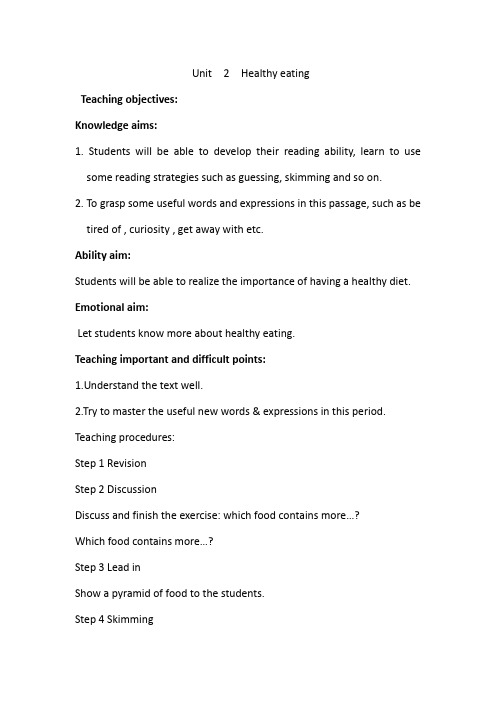
Unit 2 Healthy eatingTeaching objectives:Knowledge aims:1. Students will be able to develop their reading ability, learn to use some reading strategies such as guessing, skimming and so on.2. To grasp some useful words and expressions in this passage, such as be tired of , curiosity , get away with etc.Ability aim:Students will be able to realize the importance of having a healthy diet. Emotional aim:Let students know more about healthy eating.Teaching important and difficult points:1.Understand the text well.2.Try to master the useful new words & expressions in this period. Teaching procedures:Step 1 RevisionStep 2 DiscussionDiscuss and finish the exercise: which food contains more…?Which food contains more…?Step 3 Lead inShow a pyramid of food to the students.Step 4 SkimmingGet the students to read the whole story fast to prove whether their guesses are right.Then ask the following questions to finish the table :Qs : Whose restaurant ? What foods are offered there ? Do these foods make a healthy diet ? Why not ? What problems may these foods cause to customers ?2.Give the students 2 minutes to summarize the main idea of the story with the help of the above table, using 2 or 3 sentences.Step 5 Careful readingDivide the whole passage into three parts, and give the general idea of each part.Part 1 Wang Peng felt frustrated because he found his customers had come to other places to eatPart 2 Wang Peng found the reason why YongHui’s restaurant was more attractivePart 3 Wang Peng thought out a good idea to have a competition with YongHui’s restaurantT : The story is mainly about two persons, that is, Wang Peng and Yong Hui .Q : Who is the main character in the story ? ( Wang Peng ) Now let’s read the story again to get more about him.1.Get the Ss to read the story carefully to make a list of places where hestayed & went and his feelings in these places.2. Ask some questions to help the Ss have a better understanding of the story.Step 6 Post readingTrue or false1. Usually Wang Peng’s restaurant was full of people.2. He provided a balanced diet in his menu.3. Yong Hui served a balanced diet.4. Yong Hui could make people thin in two weeks by giving them a good diet.5. Wang Peng’s customers often became fat after eating in his restaurant.6. Yong Hui’s menu gave them energy foods.Step 7 SummaryWang Peng felt 1____ in an empty restaurant because no eaters have came to his restaurant 2_____ since he got up early in the morning. He wanted to find out why. He hurried out and 3____ Lichang into a newly-opened restaurant. He found that the owner 4____ Yong Hui was serving slimming foods to make people thin. Driven by 5_____, Wang Peng came 6____ to take a close look at the menu. He could not even 7_____ his eyes. He was 8_____ at what he saw. He hurried outside and got 9_____ to do some 10_____. After a lot of reading, he 11_____ thatYong Hui’s food made people become 12_____ quickly because it was no 13_____ food. Arriving home Wang Peng rewrote his own sign. To his joy, people began coming to his restaurant again. He was able to 14_____ his living now. He looked 15____ to being rich and he wouldn’t be in 16_____ any longer. Then all of a sudden Yong Hui walked in with anger. Wang Peng asked her to try a meal of his. Although enjoying the dumplings served there, Yong Hui looked ill and felt sick with the fatty pork and all those heavy food. They 17_____ about offering a 18 _____ diet and providing a balanced menu to cut down the fat and increase the 19_____ in the meal. They learned from each other. In the end they decided to turn the two restaurants into a big one. They got 20_____ and lived happily ever after!Homework :1.Read the story aloud and find out some beautiful sentences.2.Remember the useful words and expressions.品味人生1、不管鸟的翅膀多么完美,如果不凭借空气,鸟就永远飞不到高空。
人教版高中英语必修三Unit+2+Healthy+eating1+教案.doc
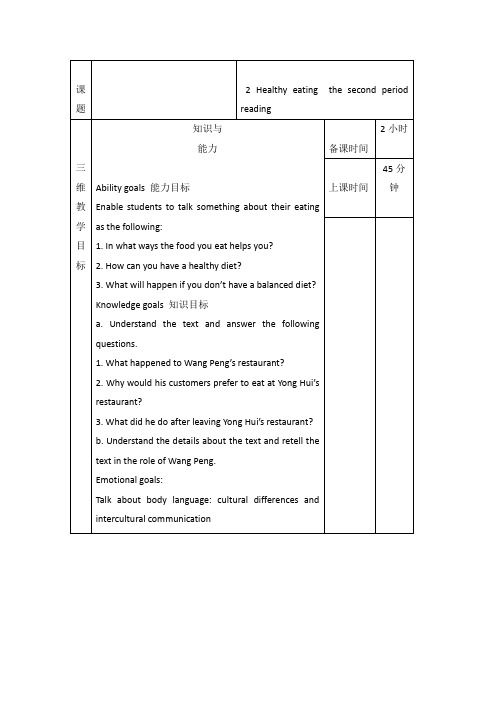
品味人生1、不管鸟的翅膀多么完美,如果不凭借空气,鸟就永远飞不到高空。
想象力是翅膀,客观实际是空气,只有两方面紧密结合,才能取得显着成绩。
2、想停下来深情地沉湎一番,怎奈行驶的船却没有铁锚;想回过头去重温旧梦,怎奈身后早已没有了归途。
因为时间的钟摆一刻也不曾停顿过,所以生命便赋予我们将在汹涌的大潮之中不停地颠簸。
3、真正痛苦的人,却在笑脸的背后,流着别人无法知道的眼泪,生活中我们笑得比谁都开心,可是当所有的人潮散去的时候,我们比谁都落寂。
4、温暖是飘飘洒洒的春雨;温暖是写在脸上的笑影;温暖是义无反顾的响应;温暖是一丝不苟的配合。
5、幸福,是一种人生的感悟,一种个人的体验。
也许,幸福是你风尘仆仆走进家门时亲切的笑脸;也许,幸福是你卧病床上百无聊赖时温馨的问候;也许,幸福是你屡遭挫折心灰意冷时劝慰的话语;也许,幸福是你历经艰辛获得成功时赞赏的掌声。
关键的是,你要有一副热爱生活的心肠,要有一个积极奋进的目标,要有一种矢志不渝的追求。
这样,你才能感受到幸福。
6、母爱是迷惘时苦口婆心的规劝;母爱是远行时一声殷切的叮咛;母爱是孤苦无助时慈祥的微笑。
7、淡淡素笺,浓浓墨韵,典雅的文字,浸染尘世情怀;悠悠岁月,袅袅茶香,别致的杯盏,盛满诗样芳华;云淡风轻,捧茗品文,灵动的音符,吟唱温馨暖语;春花秋月,红尘阡陌,放飞的思绪,漫过四季如歌。
读一段美文,品一盏香茗,听一曲琴音,拾一抹心情。
8、尘缘飞花,人去楼空,梦里花落为谁痛?顾眸流盼,几许痴缠。
把自己揉入了轮回里,忆起,在曾相逢的梦里;别离,在泪眼迷朦的花落间;心碎,在指尖的苍白中;淡落,在亘古的残梦中。
在夜莺凄凉的叹息里,让片片细腻的柔情,哽咽失语在暗夜的诗句里。
9、用不朽的“人”字支撑起来的美好风景,既有“虽体解吾犹未变兮”的执着吟哦,也有“我辈岂是蓬蒿人”的跌宕胸怀;既有“我以我血荐轩辕”的崇高追求,也有“敢教日月换新天”的豪放气魄。
33 我是一只蜜蜂,在祖国的花园里,飞来飞去,不知疲倦地为祖国酿制甘甜的蜂蜜;我是一只紫燕,在祖国的蓝天上,穿越千家万户,向祖国向人民报告春的信息;我是一滴雨点,在祖国的原野上,从天而降,滋润干渴的禾苗;我是一株青松,在祖国的边疆,傲然屹立,显示出庄严的身姿。
高一英语人教版必修3:Unit 2 Healthy eating教案 Word版含答案

Unit 2 Healthy eating教案I.单元教学目标II.目标语言Ⅲ. 教材分析与教材重组1. 教材分析本单元以“健康饮食”为中心话题,通过单元教学让学生了解各种食物对人体的作用,引导学生关注平衡膳食,促使学生养成健康饮食的习惯。
针对现实中遇到的实际问题发表自己的看法。
最后让学生运用所学知识,两人一组研究中餐,设计食谱。
1.1 WARMING UP是本单元一个重要的组成部分。
让学生看图讨论不同食物对人体的作用,了解饮食与人体健康的关系。
通过几个设问激发学生思考自己的饮食习惯是否合理,运用已有的知识经验思考什么是Healthy Eating.1.2 PRE-READING 通过一个表格和一个排序题引导学生对比不同食物中哪些食物富含脂肪、纤维素、维生素和糖份。
可添加讨论如何在烹饪中保持食物营养,从而有利于健康。
1.3 READING 讲述王鹏和咏慧开饭店的不同风格和顾客对不同食品的反应,反映了现代人对饮食的关注和对时尚的追求。
但王鹏和咏慧都没有提供平衡的膳食,经过一段时间的磨合,他们决定合作,提供既有能量又有纤维的食品。
戏剧性的结尾增添了故事的趣味性。
通过阅读丰富学生的饮食文化,教会他们如何改善饮食习惯;在现实生活中碰到麻烦时,如何正确处理矛盾,解决问题。
1.4 COMPREHENING 利用判断和回答问题的形式考查学生对课文细节的理解,对比两家饭店所提供膳食的优缺点。
1.5 LEARNING ABOUT LANGUAGE 是继Comprehending之后的又一指导性练习。
注重考查词性的变化,课文中重点词汇在语篇中的熟练运用及情态动词的不同功能,并设计连线和情景对话两个题型予以巩固。
1.6 USING LANGUAGE 体现了学以致用的目的,从Listening, Reading, Speaking, Writing 四方面训练学生,完成语言的输入性学习和输出性训练的过程,结合生活实际,让学生两人一组研究中餐设计食谱。
高中英语 Unit2 Healthy Eating教案 新人教版必修3-新人教版高二必修3英语教案
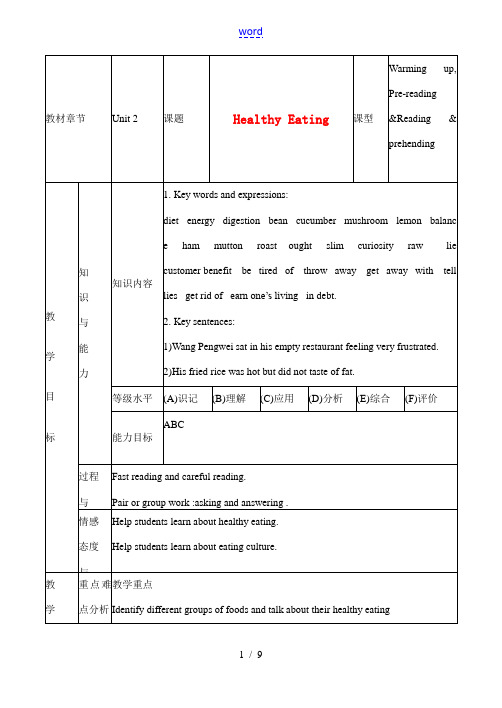
5. What should we not do before exercise?A. Eat B. Warm up. C. Drink water
How many glasses of water should we usually drink every day?
raw生的vinegar醋discount折扣ought to应该win…back赢回lose weight减肥
get away with被放过,(做坏事)不被惩罚tell a lie / tell lies说谎
→Step 4Reading
1. Fast reading
Ask students to skim the reading passage andfind out: What different places are mentioned in the text?
2. How regularly should middle school students exercise?
A. Once a week B. Once a month C. Once a day
3. What percentage of the body is made up of water? A. 40% B. 60% C. 70%
Energy food
Fibre food
2. Ask students:What is a balanced diet?
A balanced diet is the one that includes at least three dishes: energy giving foods, body-building foods and protective foods.
人教版高中英语必修3《Unit2Healthyeating》教案
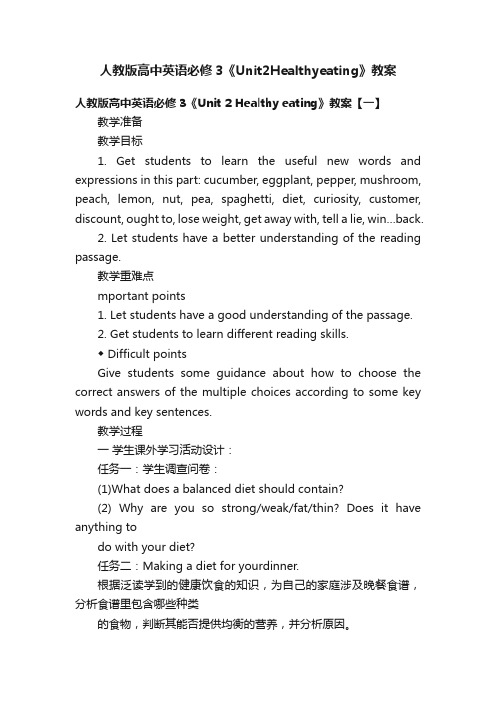
人教版高中英语必修3《Unit2Healthyeating》教案人教版高中英语必修3《Unit 2 Healthy eating》教案【一】教学准备教学目标1. Get students to learn the useful new words and expressions in this part: cucumber, eggplant, pepper, mushroom, peach, lemon, nut, pea, spaghetti, diet, curiosity, customer, discount, ought to, lose weight, get away with, tell a lie, win…back.2. Let students have a better understanding of the reading passage.教学重难点mportant points1. Let students have a good understanding of the passage.2. Get students to learn different reading skills.◆ Difficult pointsGive students some guidance about how to choose the correct answers of the multiple choices according to some key words and key sentences.教学过程一学生课外学习活动设计:任务一:学生调查问卷:(1)What does a balanced diet should contain?(2) Why are you so strong/weak/fat/thin? Does it have anything todo with your diet?任务二:Making a diet for yourdinner.根据泛读学到的健康饮食的知识,为自己的家庭涉及晚餐食谱,分析食谱里包含哪些种类的食物,判断其能否提供均衡的营养,并分析原因。
人教新课标高中英语必修三Unit+2+Healthy+eating+教案1.doc

Unit 2 Healthy eating教案1(COME AND EAT HERE<PART 1>)IntroductionIn this period, after the warming up, students will first be guided to imagine and share their views about the healthy food. They will then be helped to read a passage entitled COME AND EAT HERE.Examples of “Warming Up” designs are presented in this book for teachers’ reference. Computer and overhead projector may be used to aid the teaching and learning. Objectives⏹To talk about healthy eating⏹To making suggestions or giving advice on diet⏹To distinguish the meanings of Modal verbs⏹To make a balanced menuFocusWords fiber, digestion, bean, slim, curiosity, lie, debt, glare, limit, benefit, item, protectiveExpressions get rid of, throw away, get away withPatterns By now his restaurant ought to be full of people.Want to lose weight?He could not have Yong Hui getting away with telling people lies!AidsMultimedia facilities, tape-recorder, photos, diagramsProcedure1. Warming upReview the words of foods by showing their pictures. First, ask students to list the foods they like best. Then tick off 3 of them they eat most often. Second, show the three groups of foods and see which group their foods belong to. Third, ask the students to tell us in what ways their foods help them grow.II. Pre-reading by talking and sharingGet the students to discuss the questions with their partners in this part. Then askthem to report their work. This part will help the students understand the text.T: Please look at the slide show and discuss th e questions with your partners. Then I’ll ask you to report your work. Are you clear?III. Fast readingGet the students to comprehend the passage quickly and accurately and meanwhile help the students to form a good habit of reading. Give the students a couple of minutes to look through the whole passage. Tell the students to read the text silently and then ask for the main idea of the text on the slide show with their partners.IV. Careful readingRead the text carefully and finish the following tasks.Task 1 Divide the whole passage into three parts, and give the general idea of each part. Task 2 True or False?ually Wang Pengwei’s restaurant was full of people.2.He provided a balanced diet in his menu.3.Yong Hui served a balanced diet.4.Yong Hui could make people thin in two weeks by giving them a good diet.5.Wang Pengwei’s customers often became fat after eating in his restaurant.6.Yong Hui’s menu gave them energy foods.7.Wan g Pengwei’s menu gave them food containing fibre.8.Wang Pengwei admir ed Yong Hui’s restaurant when he saw the menu.9.Wang Pengwei decided to copy Yong Hui’s menu.Task 3 Find out the information of the two restaurants.V. Reading and translatingNext you are going to read the text COME AND EAT HERE and translate it into Chinese. VI. ListeningListen to the tape and pay attention to your pronunciation and intonation.VII. speakingIn pairs make up a dialogue about food you like or dislike using the expressions below and as many food, fruit or vegetables as possible and state your reasons.Useful expressions about likes and dislikesMy favorite food/fruit/meat is…VIII. Closing down by discussion1. What do you think Wang Peng will provide to win his customers back?2. How do you think the story will end?精美句子1、善思则能“从无字句处读书”。
- 1、下载文档前请自行甄别文档内容的完整性,平台不提供额外的编辑、内容补充、找答案等附加服务。
- 2、"仅部分预览"的文档,不可在线预览部分如存在完整性等问题,可反馈申请退款(可完整预览的文档不适用该条件!)。
- 3、如文档侵犯您的权益,请联系客服反馈,我们会尽快为您处理(人工客服工作时间:9:00-18:30)。
Unit 2 Healthy eating技能目标Skill GoalsTalk about healthy dietMake suggestions or giving advice on dietDistinguish the meanings of Modal verbsMake a balanced menu功能句式Practice talking about your ideasYes, I think so.I don’t think so.I agree.I don’t agree.That’s correct. Exactly.That’s exactly my opinion.You’re quite right.I don’t think you are right.I quite agree with you.I’m afraid I don’t agree / disagr ee with you. Of course not.I’m afraid not.All right.That’s a good idea.Certainly. / Sure.No problem.Practice giving advice and suggestions You must / must not...词汇1. 四会词汇diet, nut, bean, pea, cucumber, eggplant, pepper, mushroom, peach, lemon, balance, barbecue, mutton, roast, fry, stir-fry, ought, bacon, slim, curiosity, hostess, raw, vinegar, lie, customer, discount, weakness, strength, consult, fiber, digest, carrot, debt, glare, spy, limit, benefit, breast, garlic, sigh, combine2. 认读词汇protective, spaghetti, protein, crisp, kebab, sugary, muscle, calmly, cooperation3. 词组get away from, balanced diet, ought to, lose weight, tell a lie, win… back, earn one’s living, in debt, spy on, cut down, before long, put on weight语法The use of ought to1. StatementsYou ought to cook fresh vegetables and meat without too much fat if you want to stay slim.You ought not to eat the same kind of food at every meal.2. Difficulty1. 教材分析本单元以“健康饮食”为中心话题,通过单元教学让学生了解各种食物对人体的作用,引导学生关注平衡膳食,促使学生养成健康饮食的习惯。
针对现实中遇到的实际问题发表自己的看法。
最后让学生运用所学知识,两人一组研究中餐,设计食谱。
1.1 WARMING UP 是本单元一个重要的组成部分。
让学生看图讨论不同食物对人体的作用,了解饮食与人体健康的关系。
通过几个设问激发学生思考自己的饮食习惯是否合理,运用已有的知识经验思考什么是Healthy Eating.1.2 PRE-READING 通过一个表格和一个排序题引导学生对比不同食物中哪些食物富含脂肪、纤维素、维生素和糖份。
可添加讨论如何在烹饪中保持食物营养,从而有利于健康。
1.3 READING 讲述王鹏伟和咏慧开饭店的不同风格和顾客对不同食品的反应,反映了现代人对饮食的关注和对时尚的追求。
但王鹏伟和咏慧都没有提供平衡的膳食,经过一段时间的磨合,他们决定合作,提供既有能量又有纤维的食品。
戏剧性的结尾增添了故事的趣味性。
通过阅读丰富学生的饮食文化,教会他们如何改善饮食习惯;在现实生活中碰到麻烦时,如何正确处理矛盾,解决问题。
1.4 COMPREHENING 利用判断和回答问题的形式考查学生对课文细节的理解,对比两家饭店所提供膳食的优缺点。
1.5 LEARNING ABOUT LANGUAGE 是继Comprehending之后的又一指导性练习。
注重考查词性的变化,课文中重点词汇在语篇中的熟练运用及情态动词的不同功能,并设计连线和情景对话两个题型予以巩固。
1.6 USING LANGUAGE 体现了学以致用的目的,从Listening, Reading, Speaking, Writing 四方面训练学生,完成语言的输入性学习和输出性训练的过程,结合生活实际,让学生两人一组研究中餐设计食谱。
2.教材重组2.1 精读把Warming up作为Reading 的导入部分,把Pre-reading、Reading 和Comprehending整合在一起作为一堂“精读课”。
2.2 语言学习把Learning About Language和Workbook中的Using words and expressions, Using Structures结合在一起上一节“语法课”。
2.3 听力把Using Language 中的Listening和Workbook中的Listening,Listening Task 放在一起上一堂“听力课”。
2.4 泛读Using Language中的Reading与Workbook中的Reading Task放在一起上一堂“泛读课”。
2.5 口语将Page 13 Activity 3和Workbook中的Talking, Speaking Task放在一起上一堂“口语课”。
2.6 语言运用将Speaking and Writing和Workbook中的Writing Task, Project整合在一起上一堂“写作课”。
3.课型设计与课时分配1st period Warming up and Reading2nd period Language study3rd period Listening4th period Extensive reading5th period Speaking6th period WritingⅣ. 分课时教案The First Period Warming up and ReadingTeaching goals 教学目标1. Target language目标语言a. 重点词汇和短语energy, fiber, digestion, bean, cucumber, mushroom, lemon, ham, mutton, roast, slim, curiosity, raw, lie, customer, muscle, cheese, protective, frustrated, drive, sugary, body-building, energy-giving,newly-opened, balanced diet, ought to, tired of, throw away, get away with, tell lies, take off, be amazed at, do some resea rchb. 重点句子His fried rice was hot but did not taste of fat.Tired of all that fat? Want to be thinner? Only slimming food served here.I will take all that fat off you in two weeks if you eat here every day.It was not giving its customers energy-giving food!Something terrible must have happened if Maochang was not coming to eat with him as he always did.He wondered if he should go to the library to find out.He c ouldn’t have Yong Hui getting away with telling people lies!2. Ability goals 能力目标a. Enable students to talk about their eating.In what ways the food you eat helps you?How can you have a healthy diet?What will happen if you don’t have a balanced diet?b. Understand the text and answer the following questions.What happened to Wang Pengwei’s restaurant?Why would his customers prefer to eat at Yong Hui’s restaurant?What did he do after leaving Yong Hui’s restaurant?c. Understand the details about the text and retell the text in the role of Wang Pengwei.3. Learning ability goals 学能目标Enable the students to learn how to talk about their eating.What does a healthy diet mean?Is what Yong Hui did right? Why?What will you do if you are Wang Pengwei?Teaching important points 教学重点a. Identify different groups of foods and talk about healthy eating.b. What kind of food did they provide for their customers, healthy or unhealthy? Why? Teaching difficult points 教学难点a. Understand the real meaning of healthy eating.b. How was the competition going on? Who would win?Teaching methods 教学方法a. Fast and careful reading.b. Asking-and-answering activity to check the Ss’ understanding of the text.c. Individual, pair or group work to finish each task.d. Discussion.Teaching aids 教具准备A recorder, a computer and a projector.Teaching procedures & ways 教学过程与方式Step I Warming upWhat are the three essential elements for us human beings to survive on the earth?Water, air , foodWhich one would you prefer? Western food or Chinese food?What do you usually have for breakfast / lunch /supper ?What will happen if you do not eat a balanced diet?DiscussionWhat is healthy diet?Healthy diet: a diet that is balanced and neither too rich in fat, sugar and salt nor too poor and lacking in essential nutrients.SpeakingDecide which food is junk food or healthy food and give reasons.I think …is junk food because…I think … is healthy food because…(be rich in; be low in)Pre-reading1. What do you think should go into a good meal?A good meal should contain some food from each of the three categories above.2. Imagine you and your partner are going to invite some friends for dinner. What special food of your place would you offer them? Plan a menu.3. Look at the title of the reading passage and the pictures. Predict what the passage is about.Fast readingRead the text quickly to find out which sentence is the main idea of the text.1.The two restaurants supplied the healthy food.2.The reason why Yong Hui’s res taurant was so popular with customers.3.Wang Pengwei found out why he had lost his customer and decided to win them back.Key: 3Reading1. Usually Wang Peng’s restaurant was full of people. T2. Yong Hui could make people thin in two weeks by giving them a good diet.It would take longer than that. F3. Wang Peng’s regular customers often became fat. T4. Yong Hui’s menu gave customers more emery-giving food. FNo. it gave them protective food but no energy-giving or body-building food.5. Wang Peng’s menu gave customers more protective food. F6. Wang Peng decided to compete with Yong Hui by copying her menu. FHe decided to advertise the benefits of his menu.Post reading1. The weakness of the diet in Wang Peng’s restaurant was ______ _______________________________.2. The strength of the diet in Wang Peng’s restaurant was _________________________________ __________.Homework1. Retell the text.(1) Use the first person to retell the story.(2) Try to use proper prepositions and conjunctions.2. Prepare for the language learning and do Using Words and Expressions on WB (Page 49and 50).The second period Extensive readingPre-readingLearn these proverbs.You are what you eat. 人如其食。
